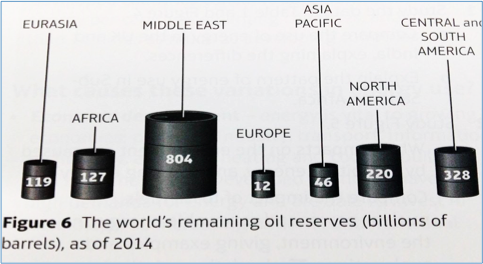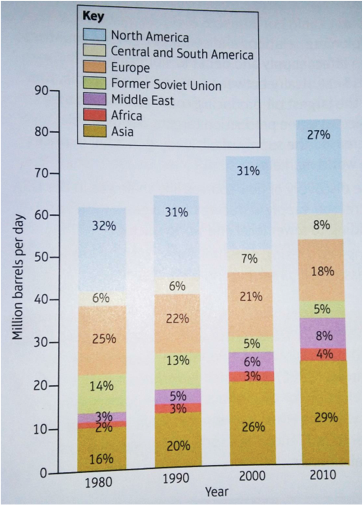Oil
How Is Oil Made
The production of oil is the World’s largest business – some of the largest TNCs (transnational corporations) are oil companies. The distribution of oil reserves, like other fossil fuels is uneven.
The global consumption of oil has been rising since the 1990s to supply the increasing demands for energy from a growing and wealthier population. One of the key factors in this growth has been rapid industrialisation and the development in emerging countries (China, India).
Oil and gas started out as tiny organisms in seas. Over millions of years, the remains of these organisms piled up. As layer upon layer of sediment accumulated and consolidated, the resulting pressure gradually created a type of sedimentary rock known as oil shales.
Variations in Price
Since 1983, the price of oil per barrel has seen big fluctuations. Rises and falls in the price of oil are influenced by changes in supply and demand, as well as significant global events
OPEC (the organisation of the Petroleum Exporting Countries)
| Countries sometimes deliberately increase supply to increase income, even if they know increasing supplies will drive price down. The price of oil fell from US$115 per barrel in 2014 to US$50 per barrel in 2015. It was caused by oversupply of oil from Saudi Arabia, Iraq, USA fracking sources and Iran. | Diplomatic relations and conflicts between countries can affect supply and demand. For example, in 2013-14, rivalry between Iran and Saudi Arabia, two of the largest oil producing countries, meant they failed to agree production targets. Saudi Arabia increased the supply of oil, leading to a fall in prices on world markets. |
| China’s rapid industrialisation in the early 21st century further increased the demand for energy which China’s own oilfields could not meet, so oil imports filled the gap. | Short term spikes in the oil price can be caused by disruptions to supply, such as the 2010 oil spill caused by an explosion on a BP oil rig in the Gulf of Mexico. Political events in the Middle East can also restrict oil supplies. |
| During periods of recession, such as after 2008, economies slowed down and consumers brought fewer goods. There was less demand for oil and prices fell. | The discovery of new sources like shale gas in the USA increased supply, reducing oil and gas imports and leading to lower local and world prices. |
| Long term, rising demands for energy are likely to put pressure on oil supply and oil prices. | Up to 2008, increasing demand caused by growth of the world’s economies led to a long-term rise in the price of oil. |
Where Has Oil
Where Consumes Oil
- Explain why oil prices fluctuate?
- Your answer should include: War / Conflict / Iraq / Money
- Name countries and areas of the world that have lots of oil reserves.
- Your answer should include: Middle / East

